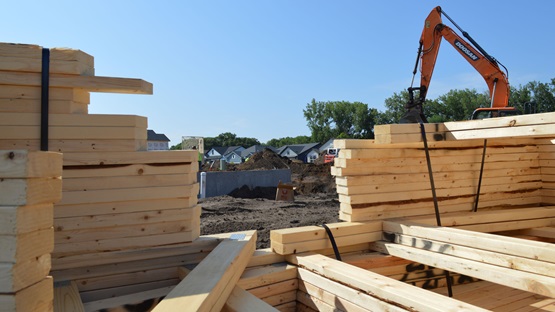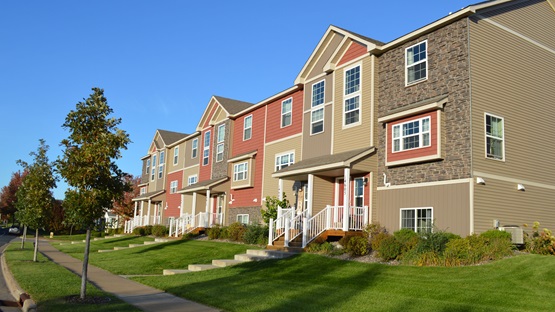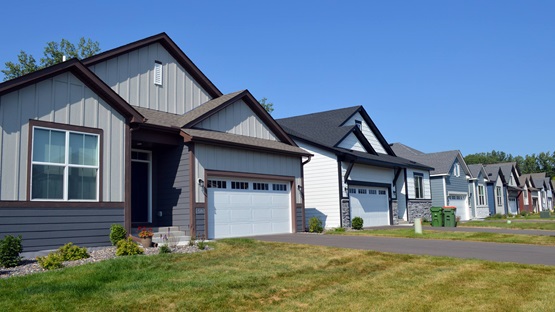Who benefits from new market-rate apartments? While these new units are typically occupied by households on the higher end of the income spectrum, the chain of residential moves brought about by their construction benefits many more households. Today’s lower-priced rental housing was often the new, expensive rental housing of yesteryear. And it doesn’t take decades for new apartments to put downward pressure on rents elsewhere in a metropolitan area. New units help keep current prices down for everyone by opening up new opportunities for low- and moderate-income renters over a few short years through a chain of residential moves.
Creating the chain
Imagine that a renter named Jim moves into a brand-new market-rate apartment. A renter named Maria moves into Jim’s old unit, which is more affordable than Jim’s new place. Another renter is going to move into Maria’s old unit. The chain will likely continue to include several more units, each progressively older and more affordable. It will end when someone moves out on their own from a previously shared living space.
This process of new construction encouraging mobility across the income spectrum is one piece of a phenomenon known as filtering. Theories connecting filtering to housing affordability are generally accepted among economists. For example, economic theory predicts that housing units should be relatively more affordable when the housing supply increases, as it does when new apartments open.
Owners and managers of older properties are well aware that new supply entering a market creates new opportunities for their renters to move up. Staff at the Federal Reserve Bank of Minneapolis recently wrapped up a research project that involved interviews with 16 large-apartment owners and property managers in the Minneapolis-St. Paul metropolitan area. Regardless of whether they owned newer or older properties, these owners and managers often cited the increased housing supply in the region as a reason why rents at their properties generally had not increased very much in the past few years.
Evidence from economist Evan Mast, who is currently with the University of Notre Dame, has helped clearly track and document how filtering works at a granular level. Mast was able to precisely document the chain of moves that follows a move like Jim’s. In other words, he used a data source that allowed him to see where Jim moved from, where Maria moved from, and so forth.
Mast found that these chains of moves lead to apartment openings in other neighborhoods relatively quickly. He estimated that, within five years, the aggregated chain of residential moves ultimately results in about 70 new openings for renters in lower-income neighborhoods for every 100 new market-rate apartments.
Mast’s work looked at 12 metropolitan areas and includes an analysis of movers and new market-rate apartments in the Twin Cities area. Local policies and markets influence the pace of housing construction and, therefore, the scale of filtering. Mast’s model suggests that relative to new construction in other metropolitan areas, new units in the Minneapolis-St. Paul metro area are even more likely to increase the availability of rental units in lower-income neighborhoods.
In the map below, the purple diamonds indicate some new apartments that opened in the metro area during Mast’s study period. The gold circles show all the people who moved as a result.
The map paints a picture: the moves that begin with a higher-income tenant finding a new market-rate home—perhaps one with granite countertops, stainless steel appliances, and even a view of the river in downtown Minneapolis—have a ripple effect that can spread across the entire Twin Cities region and the entire income distribution. When more units open up, there’s a greater supply relative to demand and, as a result, lower rents.
Filtering varies locally
The rate at which properties filter through a housing market isn’t set in stone. Lower growth in a city’s housing supply leads to less filtering for all housing units. Unless there’s a huge drop in demand for housing, cities that don’t add to their housing supply will see more competition for fewer homes, and prices and rents will increase more quickly than they otherwise would.
Another example of local variation in filtering rates comes from the owner-occupied market. Analysis by Liyi Liu and others at the Federal Home Loan Mortgage Corporation shows that filtering happens more slowly in places with more restrictions on construction. In places like San Francisco, filtering can even happen in reverse. When there are few homes relative to demand, older homes are more likely to be bought by higher-income households over time. This doesn’t just apply to Victorian-era mansions, but also to the less amenity-rich housing stock that used to be more accessible to first-time home buyers.
The policy context
Mast’s work is part of a larger body of evidence supporting the connection between housing supply and affordability. This connection is at the center of many YIMBY, or “yes in my backyard,” arguments to make housing construction easier. But skeptics may point out that higher-income households don’t only move into high-income areas; in some cases, they move into lower-income neighborhoods. And new buildings can be built in lower-income areas, too. How does filtering play out in those situations?
Such questions may be motivated by concerns about gentrification-related displacement. Gentrification occurs when higher-income households move in large numbers into low-income neighborhoods. Displacement happens when home prices, rent growth, or competition from higher-income households cause low-income households to move, even if they’d rather stay put.
Strong quantitative evidence suggests that gentrification alone does not increase involuntary moves by low-income households. Mast’s paper echoes research showing that high-income movers tend to create more opportunities through filtering than they take away through gentrification. His work also shows that the people who move into new housing in lower-income areas are most likely to come from other low-income neighborhoods. In a separate paper, Mast also finds that rent growth is actually slower in low-income neighborhoods after new market-rate apartments are built.
However, Mast himself notes that individual projects may have local impacts that diverge from the overall aggregate effect of filtering. In other words, details and local context matter. For example, filtering effects are likely to be smaller where rents are already relatively low and vacancy rates are already high; outside of revitalization projects, these areas are already unlikely to see much investment and new development.
Fortunately, policy need not choose between increasing housing affordability via market-rate housing production and supporting housing stability for lower-income households. Leaders across multiple sectors can play a role in creating more housing, which will lower housing prices at a market level—and for some of the most economically vulnerable people, targeted approaches like income-restricted rental subsidies are important tools for providing stable homes.
Providing opportunities for all
The overall body of evidence on filtering, gentrification, and displacement adds to the strong theoretical case that increasing the housing supply benefits households across the income spectrum. The policy implication? The easier it is to build new housing, the more opportunities low- and moderate-income households will have to experience housing affordability.







